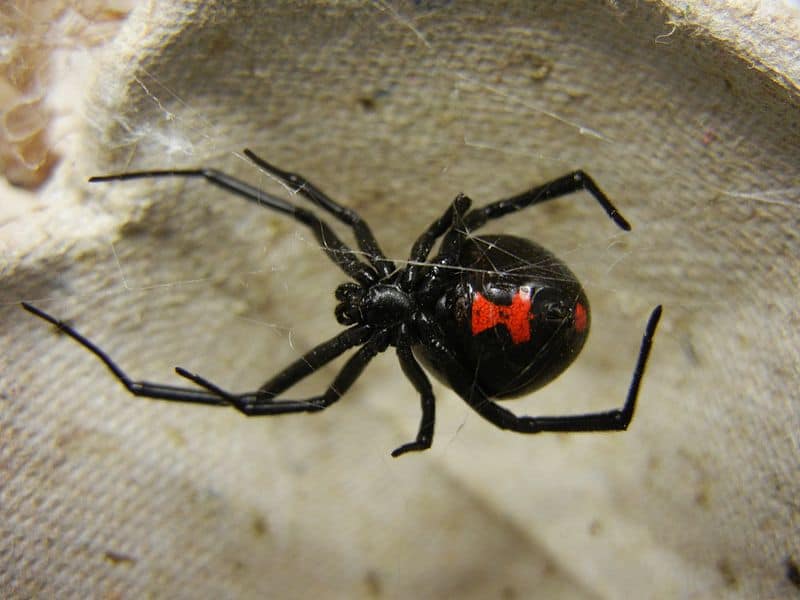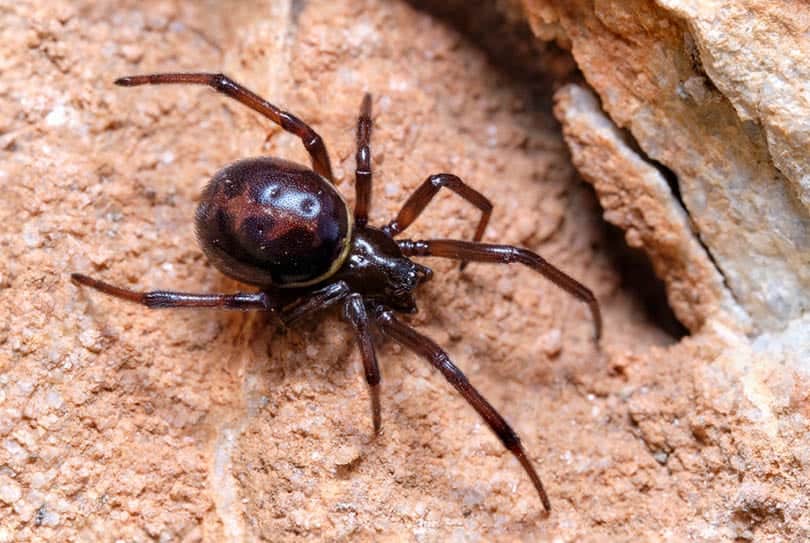With 48 different confirmed species of spiders in North Carolina, it wouldn’t make much sense for us to break down every possible spider species that you might run across.
That’s why we took a different approach and highlighted six of the largest or most poisonous spiders in North Carolina. While there are tons of different house spiders, these are the spiders that will make you stop and notice them.

The 6 Spiders Found in North Carolina
1. Black Widow

| Species: | Latrodectus mactans |
| Longevity: | 1 to 3 years |
| Good to own as a pet?: | No |
| Legal to own?: | Yes |
| Adult size: | 0.25 to 0.5 inches |
| Diet: | Small arachnids and insects |
While the black widow spider might not be the most venomous spider in the world, they are the most venomous spider in North America. But they generally live humans alone.
They prefer undisturbed locations in the wild, although they might make their way indoors during an especially cold snap in the winter.
While you certainly don’t want to get bit by a black widow, they usually aren’t deadly unless you’re a child or elderly. Still, if you suffer a severe allergic reaction, you might need to seek out medical attention at an ER.
Therefore, if you see one of these spiders in the wild, it’s best to leave them alone.
2. Brown Recluse

| Species: | Loxosceles reclusa |
| Longevity: | 1 to 2 years |
| Good to own as a pet?: | No |
| Legal to own?: | Yes |
| Adult size: | 0.25 to 0.5 inches |
| Diet: | Small insects |
The brown recluse is an extremely venomous spider that you need to be aware of if you live in North Carolina. While they’re not quite as venomous as the black widow, they’re more likely to present problems in your home.
They love dark and undisturbed locations with a ton of clutter. Therefore, they often make their home in garages, attics, and crawlspaces.
Also, unlike the black widow, which leaves a sharp sting as soon as they bite you, it often takes a little while to realize that a brown recluse has bitten you. A brown recluse bite can lead to sickness in adults, but in younger children, infants, and pets, it can be deadly.
3. Carolina Wolf Spider
| Species: | Hogna carolinensis |
| Longevity: | 1 to 3 years |
| Good to own as a pet?: | No |
| Legal to own?: | Yes |
| Adult size: | 0.75 to 1.25 inches |
| Diet: | Small insects and arachnids |
Wolf spiders are common spiders that you can spot in woodlands or even backyard gardens. While these spiders are venomous to their insect prey, they’re relatively harmless to humans.
The more significant result of a Carolina wolf spider bite is the initial pain that you feel. It’s similar to a wasp or bee sting, but after that, you might have a bit of localized swelling.
Keep in mind that these spiders are extremely quick and don’t live in webs, so it’s not too rare to find the occasional Carolina wolf spider inside your home.
4. False Widow

| Species: | Steatoda grossa |
| Longevity: | 18 months to 3 years |
| Good to own as a pet?: | No |
| Legal to own?: | Yes |
| Adult size: | 0.3 to 0.4 inches |
| Diet: | Small insects and arachnids |
As the name indicates, the false widow gets their name because they look so similar to the black widow. However, the easiest way to tell the difference is to look at their color markings.
While black widows have a red spot on their abdomen, false widows have cream-colored spots. But while the false widow isn’t as venomous as the black widow, you still want to avoid bites.
Not only does the initial bite hurt, but the venom can also lead to a severe allergic reaction. If you get bit by a false widow, monitor symptoms, and if they get too severe, seek out medical attention.
5. Yellow Sac Spider

| Species: | Cheiracanthium inclusum |
| Longevity: | 1 to 2 years |
| Good to own as a pet?: | No |
| Legal to own?: | Yes |
| Adult size: | 0.25 inches |
| Diet: | Small insects and arachnids |
While the yellow sac spider is certainly venomous, they don’t carry near as much venom as the black widow or even the brown recluse. Bites from a yellow sac spider often swell and itch, but that’s about all that you’ll notice.
They’re an extremely aggressive species that hide in clutter, so if you have a ton of junk in your attic or garage, that can be an inviting home for a yellow sac spider.
They are nocturnal hunters, which means that you likely won’t have to worry about them during the day. Still, if you have yellow sac spiders in your home, they’re a pest that you’ll need to address as soon as possible.
6. Southern Trapdoor Spider
| Species: | Ctenizidae |
| Longevity: | 5 to 20 years |
| Good to own as a pet?: | Yes |
| Legal to own?: | Yes |
| Adult size: | 1 inch to 3 inches |
| Diet: | Small insects and arachnids |
The Southern Trapdoor Spider is a large spider that you can find in North Carolina. They live in burrows and rarely enter homes, and they embody the notion that spiders are more scared of you than you are of them.
These timid spiders rarely bite, but their bites can be extremely painful if you try to handle one. Outside of the initial pain, though, they don’t carry enough venom to hurt you, though a little localized swelling can occur.
Due to their long lifespan and docile nature, they make a great pet if you’re looking for a pet spider.
The 6 Tips for Preventing/Removing Spider Infestations
Most Americans don’t want a spider infestation in their home, which means you need to follow a few tips and tricks to keep the arachnids at bay. We broke down six outstanding ways to prevent or remove spider infestations here.
1. Remove clutter and keep things tidy
Spiders love to hide, especially throughout the day. The more clutter that you have around, the more likely you are to attract spiders. By keeping things neat and tidy, spiders have fewer places to hide and are less likely to linger inside your home.
2. Seal cracks and openings
If the spiders can’t get in your home, you’re less likely to deal with an infestation. Install door sweeps on all your doors, and keep screens on windows. While this won’t prevent all spiders from entering your home due to their small size, it’ll certainly help.
3. Remove outdoor clutter
Since spiders like hiding in clutter inside your home, they enjoy plenty of hiding spaces outside your home too. This includes rocks, vegetation, and other hidey holes.
It’s only a small crawl from outside your house to the inside, so you’ll need to keep these areas in check to keep spiders from invading.
4. Apply a pesticide
While many people don’t want to apply pesticides around their homes, these do a remarkable job at keeping spiders out or killing them as soon as they enter.
Spiders can’t fly into the room, so if you can spray all the surfaces around a window or door, it’s a great way to keep spiders out of your home.
5. Keep outdoor lights off at night
While lights don’t attract spiders, they do attract their prey. Not all spiders wait in webs for food, so having insects flock to the lights at night is a great way to have spiders flocking to your home too.
6. Spray peppermint, citrus, or mint essential oils
Even if you’re using a pesticide, it’s a good idea to spray scented essential oils around door and window frames to keep spiders away. Spiders can’t stand the smell of peppermint, citrus, or mint, so a little scent can go a long way.
Keeping a Spider as a Pet
While keeping a spider as a pet isn’t for everyone, some people love watching arachnids live their lives. Keep in mind that while some arachnids will attack you every time that you open the enclosure, there are few docile options.
We recommend keeping a spider that has a longer lifespan, doesn’t live in webs, and doesn’t have a ton of venom. This reduces the chances of getting bit and needing to seek out medical attention.
Keep in mind that no matter what type of spider you own, you need an enclosure with a locking lid; otherwise, your pet spider will try to escape.

Conclusion
Love ‘em or hate ‘em, spiders are a part of the world, and there’s no getting away from them. You can install measures to keep them at bay, but don’t think that you can eradicate spiders completely from your life.
The best thing that you can do is know what you’re working with and know when you need to seek out medical attention to keep you and your family safe!
Related Read:
Featured Image Credit by Macronatura.es, Shutterstock
